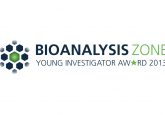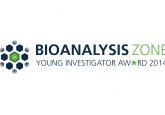2015 Young Investigator finalist: Casey Burton


Nominee:
Nominated By:
Supporting Comments:
What made you choose a career in bioanalysis?
I continue to be inspired by a family friend and six-time cancer survivor with recalcitrant breast cancer. As admirable as her story is, her struggles were wholly preventable with simple screening techniques. She meanwhile shares her story with millions of other cancer victims, a consideration that led me to pursue cancer research as a career. My own interests in biochemistry and analytical chemistry refined my research direction toward developing analytical techniques for emerging biomarkers for earlier cancer detection. The result has been highly rewarding with the freedom to pursue my research interests with clinically translational outcomes for cancer patients.
Describe the main highlights of your bioanalytical research, and its importance to the bioanalytical community.
My research efforts aim at the development of novel, cost-effective bioanalytical techniques for clinical analysis of emerging urinary biomarkers for earlier cancer detection. Urine-based cancer screening represents a new direction for cancer diagnostics that is particularly attractive for its noninvasive modality, abundant specimen volumes, and relatively simple matrices compared with serum and tissue analyses. I have found the emerging area of urinary metabolomics to be especially engaging as a powerful, new platform for cancer biomarker discovery and validation. Here at Missouri S&T (MO, USA), I developed targeted bioanalytical techniques for several biomarker panels including sarcosine and alanine, 25 urinary and cellular pteridines, the urine metallome, and others. My research frequently encounters and addresses emerging challenges to these new fields such as isomeric interferences, panel size limitations, and selection of appropriate surrogate normalization biomarkers for renal function. My recent contributions to overcoming urine normalization factors, particularly in regard to urine specific gravity, have been especially impactful on the bioanalytical community, evidenced by Letters to Editors, numerous citations, over 2000 article downloads and a top viewed paper in Analytical Methods. Finally, my bioanalytical techniques have directly initiated several clinical trials at Mercy Hospital to determine clinical applicability of pteridine and metallomic cancer biomarkers.
Describe the most difficult challenge you have encountered in the laboratory and how you overcame it.
Pteridine bioanalysis is notoriously complicated by trace concentrations, three oxidative states, poor solubility in common solvents, and sensitivity to heat and light. These challenges are even more apparent for intracellular pteridines, which has been a key roadblock to establishing biological relevance for these cancer biomarkers. For this reason, I received a NSF EAPSI Fellowship to address these challenges at Peking University (China). Unlike other techniques that fully oxidize pteridines to a single state, my technique sought to preserve their native speciation which may provide new insights to potential pathophysiological mechanisms. However, my use of ammonium hydroxide as a solubility enhancer further complicated these efforts. Dithiothreitol, an antioxidant was eventually selected and optimized to counter these problematic effects and permit native pteridine profiling. Yet, there still remained the substantial challenge of effectively extracting the intracellular pteridines. Extractive techniques had never been described for pteridines while common metabolite extraction methods would adversely promote oxidative processes. So I developed a method based on techniques used for similarly polar nucleosides that eventually involved cryogenic cell lysis and enough ammonium hydroxide and dithiothreitol to carefully extract the fragile pteridine species. These advances are now being used to establish biological relevance of pteridines in cancer.
Where do you see your career in bioanalysis taking you?
The unique and intriguing research opportunities in bioanalysis have overwhelmingly inspired me to pursue a bioanalytical research faculty position at a top academic institution. Specifically, my research will entail an interdisciplinary character that aims to solve critical research questions related to the development of diagnostic techniques for molecular cancer biomarkers. Important research questions will include how to develop innovative biomarker panels that utilize multimodality biomarkers and employ sufficiently large panels to minimize overdetection of indolent disease, how to accurately adjust urinary biomarkers to urine concentration-dilution without introducing undesirable bias, and how to develop high-throughput methodologies to simultaneously screen for novel biomarkers while quantitating established biomarkers. In order to realize these research goals, I will rely heavily on valuable collaborative efforts with medical institutions and clinics while developing rich international collaborations to pursue the specific expertise necessary to address these questions. My current progress toward these goals is already well-evidenced by my existing collaborations with Peking University, Lawrence-Berkeley National Laboratory, Mercy Hospital, Phelps County Regional Medical Center, and others. While I have so far found bioanalysis to be highly rewarding and exciting, I fully anticipate new, intriguing research opportunities that will hopefully lead to new, useful technologies for early cancer detection.
How do you envisage the field of bioanalysis evolving in the future?
The growing bioanalytical community and rapid development of advanced analytical techniques have undoubtedly paralleled technological advances in instrumentation and software design. Similarly, I anticipate new technological advances will continue to drive bioanalytical research. For example, modern biomarker panels rarely exceed a handful of selected compounds for quantitation purposes. However, small panels considerably limit diagnostic accuracy while often raising concern for overdetection of indolent disease. Technological limitations, usually in the form of resolution or scan speeds, often impose these bioanalytical panel size limits. The ability to simultaneously profile a metabolome while quantitating targeted biomarkers, especially in mass spectrometry, is similarly affected by scan/acquisition speed. Meanwhile, increasing accessibility of high-resolution instrumentation will enable direct analysis of compounds without the need for complicated sample preparation and difficult analyte separation. Technological improvement in instrument sensitivity will also be critical to measuring trace biomarkers that were previously difficult or even impossible to detect. Intelligent biomarker databases will further reduce technique interferences while providing researchers instant access to biological relevance and biofunctionality of selected compounds. Taken together, it becomes easy to see how technological advances will drive the bioanalytical community while empowering researchers to develop innovative methodologies to solve an increasingly wide array of research questions.
Please list up to five of your publications in the field of bioanalysis:
1. Burton C, Shi H, Ma Y. Simultaneous Detection of Six Urinary Pteridines and Creatinine by High-Performance Liquid Chromatography-Tandem Mass Spectrometry for Clinical Breast Cancer Detection. Anal. Chem. 85(22), 11137—11145 (2013).
2. Ma Y, Burton C. Pteridine Detection in Urine: The Future of Cancer Diagnostics? Biomarkers Med. 7(5), 1—3 (2013).
3. C. Burton, H. Shi, Y. Ma. Normalization of urinary pteridines by urine specific gravity for early cancer detection. Clin. Chim. Acta 435, 42—47 (2014).
4. Burton C, Weng R, Yang L, Bai Y, Liu H, Ma Y. High-throughput intracellular pteridinic profiling by liquid chromatography – quadrupole time-of-flight mass spectrometry. Anal. Chim. Acta 853, 442—450 (2015).
5. Burton C, Gamagedara S, Ma Y. A Novel Enzymatic Technique for Determination of Sarcosine in Urine Samples. Anal. Methods 4, 141—146 (2012).
Please select one publication from above that best highlights your career to date in the field of bioanalysis and provide an explanation for your choice.
Burton C, Gamagedara S, Ma Y. A Novel Enzymatic Technique for Determination of Sarcosine in Urine Samples. Anal. Methods 4, 141—146 (2012).
This paper critically introduced to the bioanalytical field that creatinine-based normalizations are often impractical for biomarker analysis and further suggested urine specific gravity as a useful alternative. We have noticed reverberations throughout the community from this study including controversial discussions as well as adoption of the idea from other researchers. This paper has also led us to consider more appropriate normalization factors for specific biomarkers to improve diagnostic accuracy.





